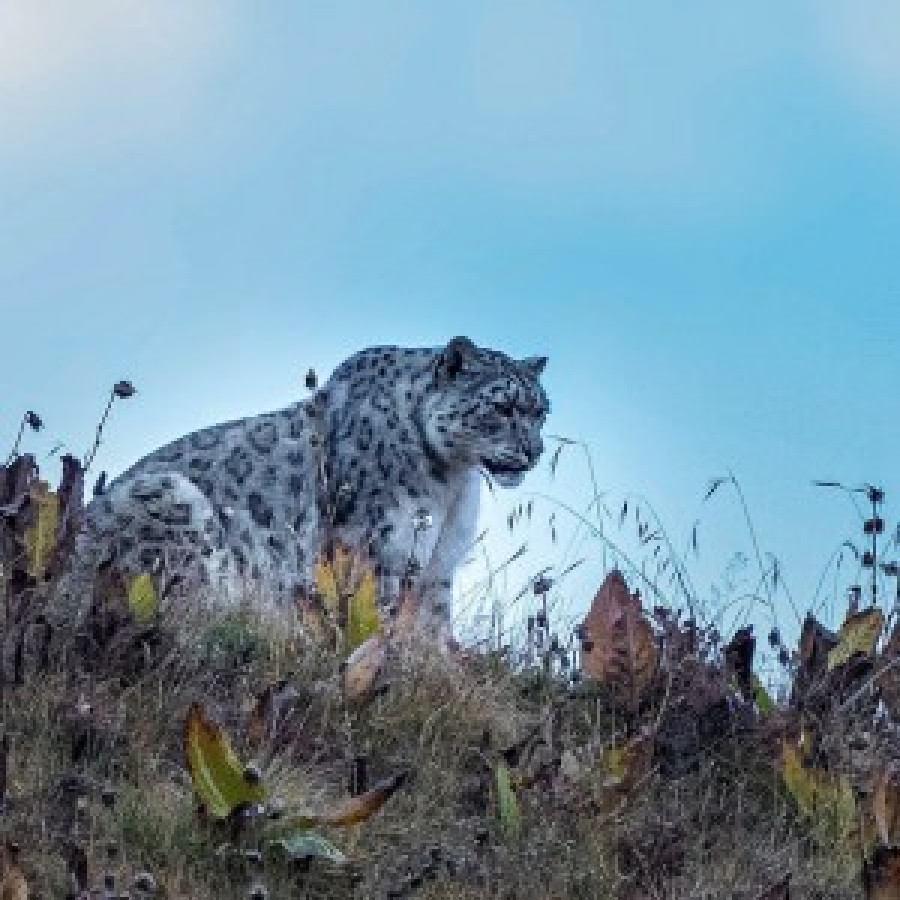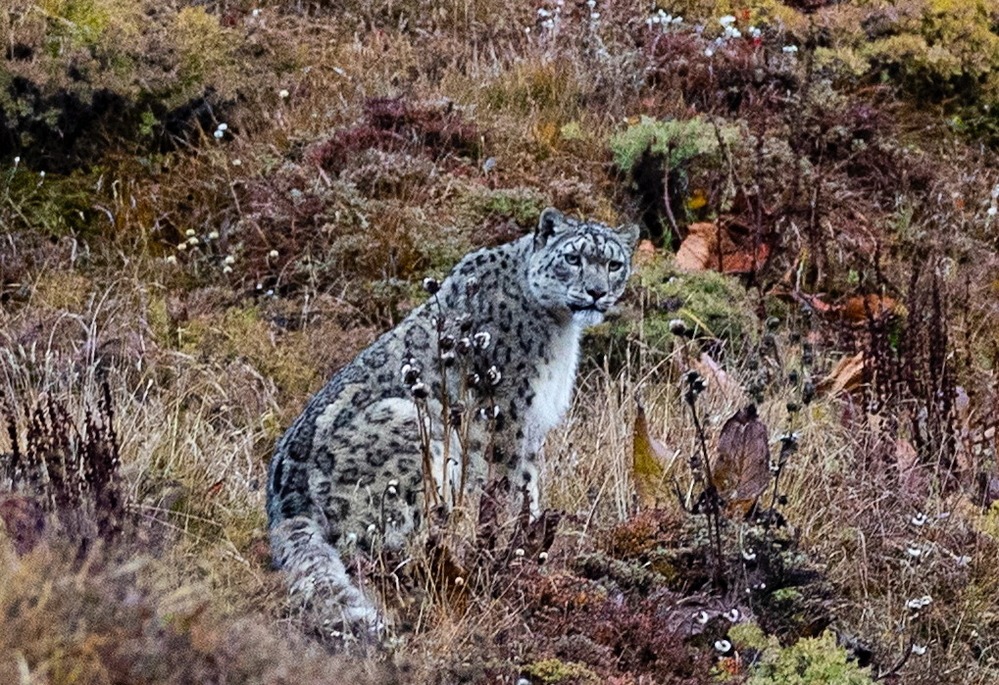National
Snow leopards in Nepal: Rare predators of high Himalayas
With just 397 in numbers, these elusive big cats face habitat loss and climate threats, but could become a major tourist attraction while helping maintain ecological balance.
Manoj Paudel
Snow leopards have carved out their habitats, from the frigid heights of the Himalayas to the vast highland plains. Rarely seen by humans, this elusive predator inspires both fear and fascination. Known as a mysterious hunter, it mesmerises those fortunate enough to catch a glimpse, its appearance both striking and captivating.
Compared to other leopards, snow leopards are exceptionally beautiful and captivating. Their presence fascinates all who see them. They differ from other leopards in body structure, behaviour, and habitat preference. As one of the most striking big cat species, they enthral people worldwide. Their pale, snowy surroundings enhance their allure, leaving those fortunate enough to glimpse them feeling truly privileged.
However, snow leopard conservation faces serious threats from climate change, habitat loss, and poaching. Hemsagar Baral, Nepal representative of The Snow Leopard Trust, USA, said climate change disproportionately affects high-altitude habitats, reducing prey populations and endangering snow leopards. The decline of blue sheep and other prey species has further compounded their challenges.
When food is scarce, snow leopards may leave their usual habitats in search of new ones, exposing themselves to danger. Venturing into new areas can trigger conflicts with other snow leopards or lead to retaliatory killings. Baral emphasised that these risks make their survival increasingly precarious. He urged people to dedicate at least 23 minutes on October 23, World Snow Leopard Day, to raise awareness and support conservation efforts.
Nepal is home to 397 snow leopards, according to data collected from 2015 to 2025 using genetic surveys and camera traps. Studies in areas including Kanchenjunga, Gaurishankar, the Manaslu–Annapurna Conservation Area, and remote regions such as eastern Dolpa, Shey Phoksundo, and Humla helped determine this number. The Department of National Parks and Wildlife Conservation released the report in April–May 2025.
Conservationists are heartened by the discovery of a healthy snow leopard population in Nepal. Naresh Subedi, member-secretary of the National Nature Conservation Fund, said developing snow leopard viewing trails could boost tourism revenue. “Nepal has strong potential for snow leopard tourism,” he said. “Tourists willing to pay to see tigers would pay even more to see snow leopards. Linking these trails to local livelihoods could benefit the economy and create jobs.”
Globally, 10 percent of snow leopards live in Nepal, despite the country accounting for only two percent of the world’s suitable habitat. Around 30 percent of their potential habitats in Nepal are protected, while 70 percent fall outside protected areas, creating additional challenges. Snow leopards are also found in Afghanistan, Bhutan, China, Kazakhstan, Kyrgyzstan, India, Mongolia, Russia, Pakistan, Tajikistan, and Uzbekistan, primarily in the Himalayan and highland regions.

Snow leopards typically inhabit elevations between 2,700 and 5,600 metres but have been recorded at heights of up to 6,000 metres.
Classified as rare and endangered, snow leopards play a crucial role in maintaining Himalayan biodiversity. They are considered an indicator species of a healthy mountain ecosystem. Preying on blue sheep, Himalayan tahr, musk deer, and serow, they naturally regulate these populations.
Sometimes called an umbrella species of the Himalayas, snow leopards act as a protective “umbrella” for prey species against extreme weather. Where snow leopards are present, populations of blue sheep, tahr, and musk deer remain healthy. Rinzin Phunjok Lama, a Rolex award-winning snow leopard expert, said snow leopards play a key role in maintaining the balance of wildlife populations.
“They are slightly smaller than regular leopards, with thick fur covering their bodies,” Lama said. “Their paws and face have small black spots. Their heads are large relative to their bodies, and their tails are long. The pale grey coat features large dark brown rosettes. Their large paws enable them to hunt sizeable prey efficiently.”
Professor Karan Bahadur Shah, who has studied snow leopards for years, said their thick, long fur allows them to survive temperatures as low as minus 40 degrees Celsius. “Their bodies appear adapted to endure the harsh conditions and remoteness of the high Himalayas,” he said.
Snow leopards have short tails and large nasal passages that help them breathe in thin mountain air. Their light grey, long, and dense fur, large paws, and long flexible tail help them move on snow and maintain balance on rocky terrain.
Snow leopards inhabit cliffs, gorges, valleys, forests, and rocky mountains. Like leopards and tigers, they mark territories by scratching, urinating, and leaving scent marks on rocks. Professor Shah noted that they leave more marks during mating season.
Male snow leopards weigh 45–55 kg, while females weigh 35–40 kg. Their legs are short, suited to mountainous terrain. The forehead is broad, and the muzzle is raised. Their coat is light grey with dense fur on the back up to 12 cm long, keeping them insulated. Their tails often appear longer than their body.
Females seek males after three years of age. Mating occurs from January to March. After a 93–110 day gestation, females give birth to 1–5 cubs in June–July. Cubs are dark-coloured at birth and rely on milk and solid food from their mothers until they learn to hunt. Newborns weigh 500–650 grams, with eyes closed. In the wild, snow leopards live about 12 years, but they have survived up to 19 years in captivity.
During mating, snow leopards vocalise with long calls resembling those of domestic cats to signal their presence, said Rinzin Phunjok Lama.




 13.12°C Kathmandu
13.12°C Kathmandu














